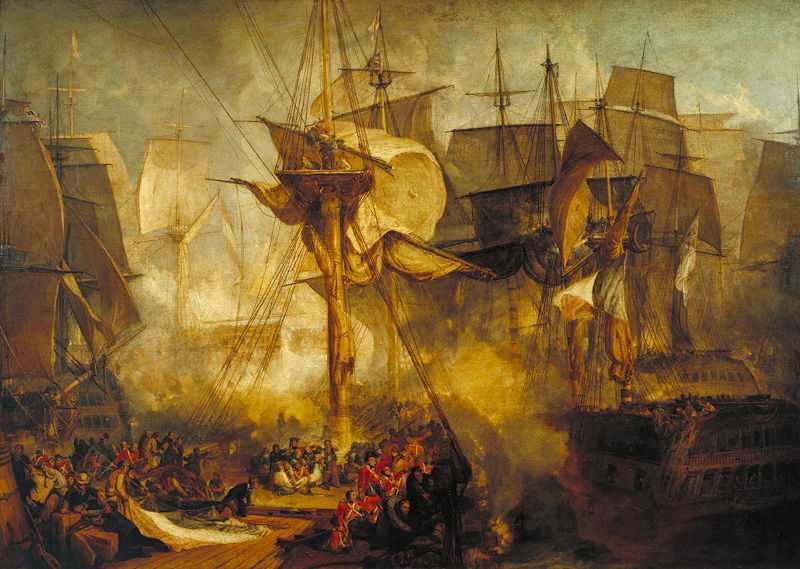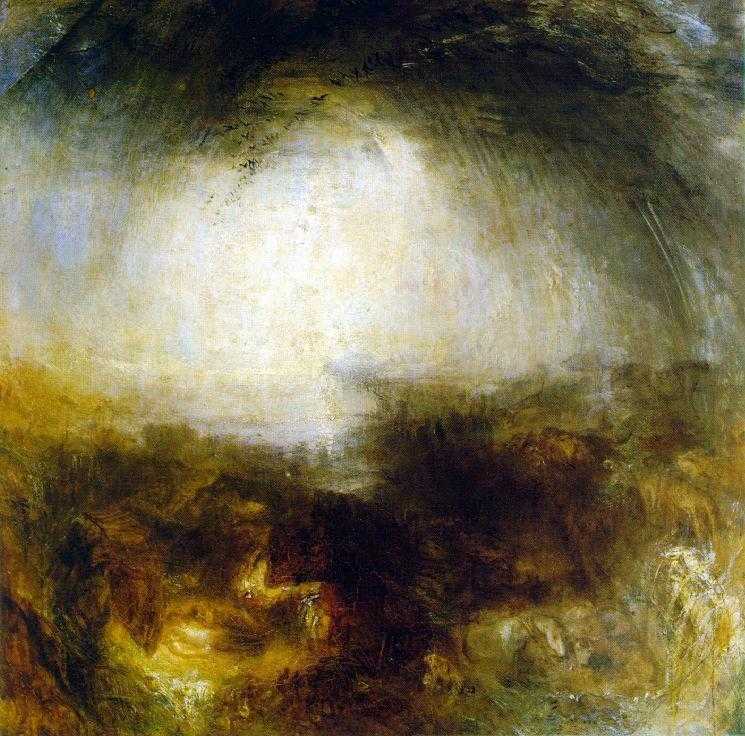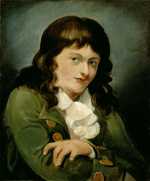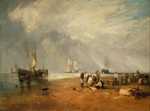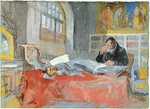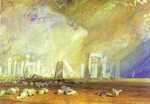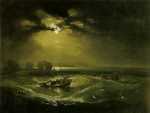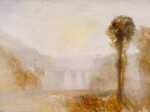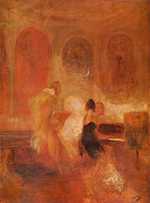1. Turner's early years
Born in London, England, on April 23rd 1775, Turner had humble beginnings.
His mother, Mary Marshall, came from a family of butchers whilst his father, William Turner, was a barber and wig maker.
From as young as 10, Turner left his family home and went to stay with his uncle in Brentford, Middlesex but he never lost his London accent. It is thought that the move was due to the failing health of his mother and he moved between several different family members during this period of his life.
In the small town to the west of London, Turner began to produce some of his earliest works. Many of these compositions depicted the sea, a theme that recurred throughout his work and into his later life. These professional quality paintings, with surviving examples dated to 1787, were displayed in his father’s shop and sold to his customers for shillings.
Turner's first influences
As well as these paintings, landscape sketches and watercolours of the English countryside, Turner also gained work with engravers. He made designs for the ‘Copper Plate Magazine’ and the ‘Pocket Magazine’. Similarly, he was employed for a time making copies of the works by the landscape painter John Robert Cozens. It is thought that these studies started him on his path towards a more imaginative approach to landscape painting that he developed more as he honed his craft.
Much of his early output included architectural subjects thanks to his work with several architects and later with a topographical draughtsman. This aspect of his early career can be seen in many of his drawings and watercolours, prior to his entry into the Royal Academy.
2. Early career
Turner joined The Royal Academy of Art in London at the age of 15, having completed just 5 years of conventional schooling.
He was made an Academy member a year later. His acceptance into the academy marked the start of his illustrious career, defined by fame and controversy in equal measure.
He garnered great attention in the Academy for his expertise in painting detailed landscapes and especially for capturing light in his artworks. Just months after his enrolment in the famed institution, Turner’s work was featured in the Royal Academy's annual exhibition. He was the youngest person in history to have this opportunity. After that point, his work was exhibited by the Academy every year.
Driven by obsession
The career of the young painter was driven by his obsession with being the best among his peers. He had ambitions to become one of the greatest artists in history and spent the majority of his time striving for this goal. Unlike many of his peers, he had no interest in building up an enviable social life or furthering his position in society. Instead, he spent hours closely studying the work of other artists, especially the French and Dutch masters.
Many of his early works exhibit his desire to replicate the works of these famous painters and he depicted his subjects with as much minute detail and realism as possible. However, he also began experimenting with his style and pushing the boundaries in his use of light and composition.
Turner's studio & gallery
In around 1800, Turner moved his studio to 64 Harley Street, London and opened a private gallery four years later. Here he both produced and showed his latest work, painting commissions and increasing his personal wealth and fame. Records suggest that at this time his mother became seriously ill and was admitted to a mental hospital. As a result, his father went to live with him and became Turner’s full-time studio assistant, as well as his cook and gardener.
3. Turner's finest works
Over the course of his life, Turner produced over 550 oil paintings, 2,000 watercolours and 30,000 works on paper including sketches and drawings.
His immense productivity serves as evidence for his infatuation with art and the way in which he dedicated his life to furthering his artistic ability. There is a clear evolution in his painting from his earlier style to his later works, becoming increasingly abstract as he grew older.
Fishermen at Sea
One of his earliest works to achieve critical acclaim was ‘Fishermen at Sea’, the first painting he displayed at the Royal Academy. Depicting a boat in the moonlight, it was a scene that was typical for fashionable paintings at this time.
The inclusion of two pools of moonlight to light his subject, an artistic device that was not an accurate depiction of the nighttime landscape, helped to draw viewers into the scene. At the same time, it demonstrated Turner’s early flair for originality and interest in playing with light. It was highly praised by critics at the time and he garnered significant recognition that helped to push him forward in his early career.
Romanticism
As he grew older, Turner’s style began to change as he experimented with Romanticism. He began to paint using far more expressive colours and brushwork. Works like ‘The Shipwreck’, produced in 1805, demonstrate his early experiments with this style to create a sense of drama through the haziness and fluidity of his brushstrokes. It is not known if the inspiration for the painting was an actual shipwreck or a poem by William Falconer, reissued in 1804. Nonetheless, Turner maintained a passion for the sea for his whole career and many of his paintings have maritime themes.
The Fighting Termeraire
Turner's best-known work is The Fighting Termeraire, a vivid painting of a naval ship being towed up the Thames to be scrapped at Rotherhithe. Executed in 1838, the painting depicts HMS Termeraire, a 98-gun Neptune class ship that fought at the Battle of Trafalgar. But the eye is drawn to the setting sun towards the right-hand side of the painting.
The striking range of colours--whites, yellows, oranges and reds--are possible because the sun's rays are diffused through a cloud.
The Fighting Termeraire was voted the nation's favourite painting in a 2005 BBC Poll. It is on permanent display at London's National Gallery.
Turner's travels
Among Turner’s extensive oeuvre, some of the works that stand out most include his paintings inspired by his travels abroad. Much of his time was spent travelling and producing works inspired by the landscapes he found. He liked to travel in the summer, at first around England and Wales and later throughout Europe.
Among the countries he visited regularly were Italy, Switzerland and France. He was particularly captivated by the mountains of the continent. ’Venice, from the Porch of Madonna della Salute’, painted in 1835, is one painting inspired by Turner’s travels to Italy. He did not begin the painting until he was back home in England, using sketches drawn whilst overlooking the Grand Canal. The warm colours and diffusive light are an example of his mastery of this style of painting.
As well as landscapes, Turner was heavily inspired by nature and the powerless of man in comparison. As such, many of his works have a perilous atmosphere that highlights the strength of the natural world. This is demonstrated in some of his most famous works including ‘Snowstorm, Steamboat Off A Harbour's Mouth’ from 1842. It is said that Turner had himself tied to the mast of a ship to experience a storm first-hand and the swirling, threatening depiction of the storm in this painting has an energy and danger that makes that story seem very likely.
A different approach
In contrast to the fine and delicate work of his contemporaries, Turner often used surprising, vibrant colour palettes to lend his work more emotion. This is particularly obvious in works like ‘Slavers, Throwing Overboard The Dead And Dying’ from 1840 where red and orange hues contrast with the ocean setting. In doing so, he tackles an emotional and political subject, depicting the brutality of the scene through his use of colour.
As well as his experimentations with colour, Turner had a unique way of applying paint to his canvases. He would move the paints around with his brush on the canvas until he reached his desired level of brilliance, shunning the conventional technique of careful layering that was common at the time. This transformed his paintings into vivid displays of light and colour that are mesmerising and expressive.
4. Turner's Legacy
Turner died on 19th December 1851, having lived out his final years in a hovel away from public life.
Despite the considerable fame and fortune he amassed during his life, he chose to die in secrecy.
This was in keeping with his eccentric life in which he had shunned social conventions in favour of focussing on his art. When his death was discovered, no one knew exactly how old he was or when he had passed.
He was buried in St. Paul’s Cathedral.
After his death
Now, more than 150 years after his death, Turner is considered to be one of the greatest artists in British history (alongside Thomas Gainsborough, John Constable and Alfred Sisley).
His art has inspired hundreds of painters, including Claude Monet and other greats of the Impressionist movement.
In conjunction, he has been attributed with paving the way for the Abstract Expressionists and the emergence of modern art as we know it today. Though he was a controversial figure during his life, he is now regarded as an indisputable visionary and trailblazer.
Rain, Steam and Speed
Another of Turner's greatest paintings was Rain, Steam and Speed. Capturing a speeding train crossing a bridge whilst being pounded by rain, this painting was an iconic representation of the industrial revolution. The bridge is the Maidenhead Bridge, completed in 1838 (six years before the painting), one of the many accomplishments of Isambard Kingdom Brunel's Great Western Railway.
Resources
Rain, Steam and Speed and the Fighting Termeraire are in the permanent collection of London's National Gallery. The largest collection of Turners is, however, to be found in the Tate Britain's Clore Gallery (including Peace - Burial at Sea and Norham Castle: Sunrise). Turner was also the subject of the critically acclaimed film Mr Turner. This Mike Leigh film was released in 2014 and starred Timothy Spall.
